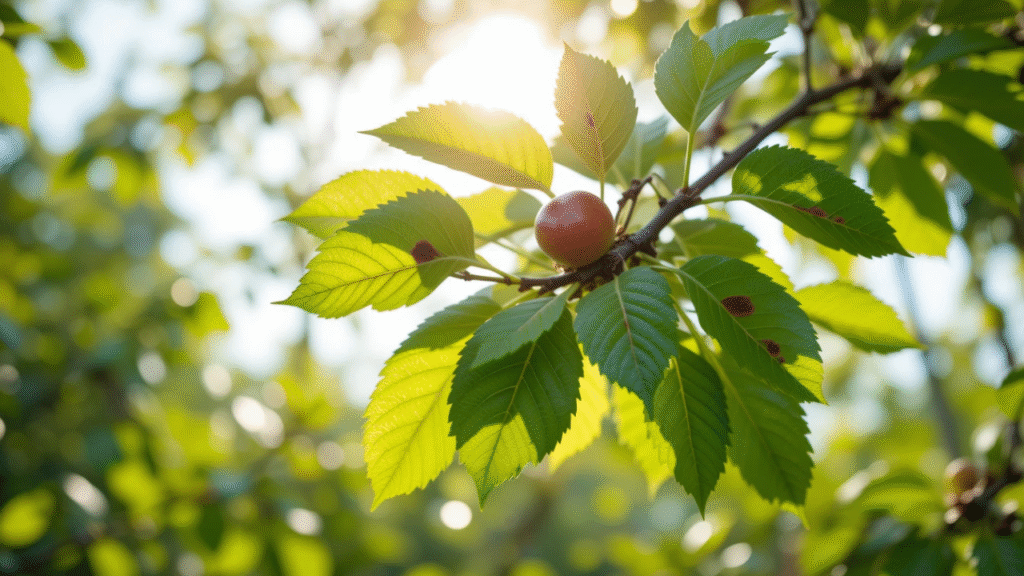
Cherry Tree Leaf Spot: How to Identify, Prevent, and Treat It for Healthy Trees
Cherry trees are a beautiful addition to any garden, providing stunning blossoms and delicious fruit. But, just like any plant, they are vulnerable to diseases that can affect their health and beauty. One such common problem is Cherry Tree Leaf Spot. If you’ve noticed unsightly spots on your cherry tree’s leaves, you might be wondering how to address the issue. In this article, we’ll dive into Cherry Tree Leaf Spot: How to Identify and Treat It, offering practical advice to help you keep your tree healthy and thriving 🌳. Whether you’re a seasoned gardener or a newbie, this guide will give you all the tools you need to tackle leaf spot and maintain vibrant, flourishing cherry trees 🍒. Let’s get started!
Table of Contents
Toggle🌿 What is Cherry Tree Leaf Spot?
Cherry Tree Leaf Spot is a common fungal disease that affects the leaves of cherry trees, causing small, dark spots to appear on the foliage. 🌰 These spots are typically round or irregular in shape and can be yellow, brown, or black. While it’s usually not fatal to the tree, if left untreated, it can lead to premature leaf drop and weaken the tree over time. 🍂
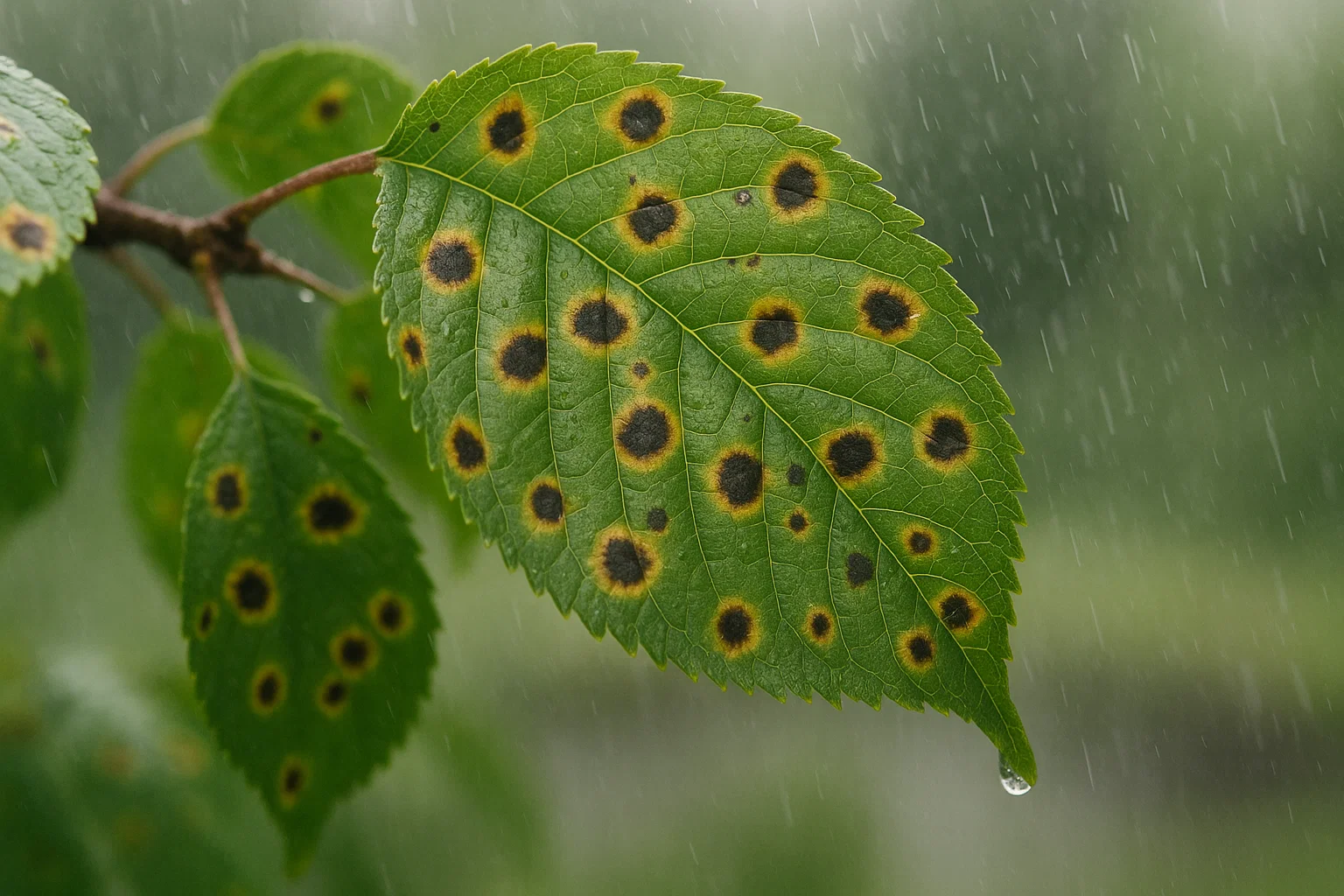
The disease is caused by different types of fungi, with Coccomyces and Blumeriella being the most common culprits. The fungi thrive in wet, humid conditions, especially during rainy seasons. 🌧️ When spores from these fungi land on the leaves, they infect the tissue, causing spots that expand as the disease progresses.
If you notice these spots on your cherry tree, it’s important to take action quickly to prevent further damage and protect the health of your tree. For step-by-step guidance on dealing with this issue, read Cherry Tree Leaf Spot: How to Identify and Treat It.🌳
👀🍃 How to Identify Cherry Tree Leaf Spot 🍃👀
Identifying Cherry Tree Leaf Spot early is essential to protecting your tree and preventing the spread of the disease. Here are the key signs to look for:
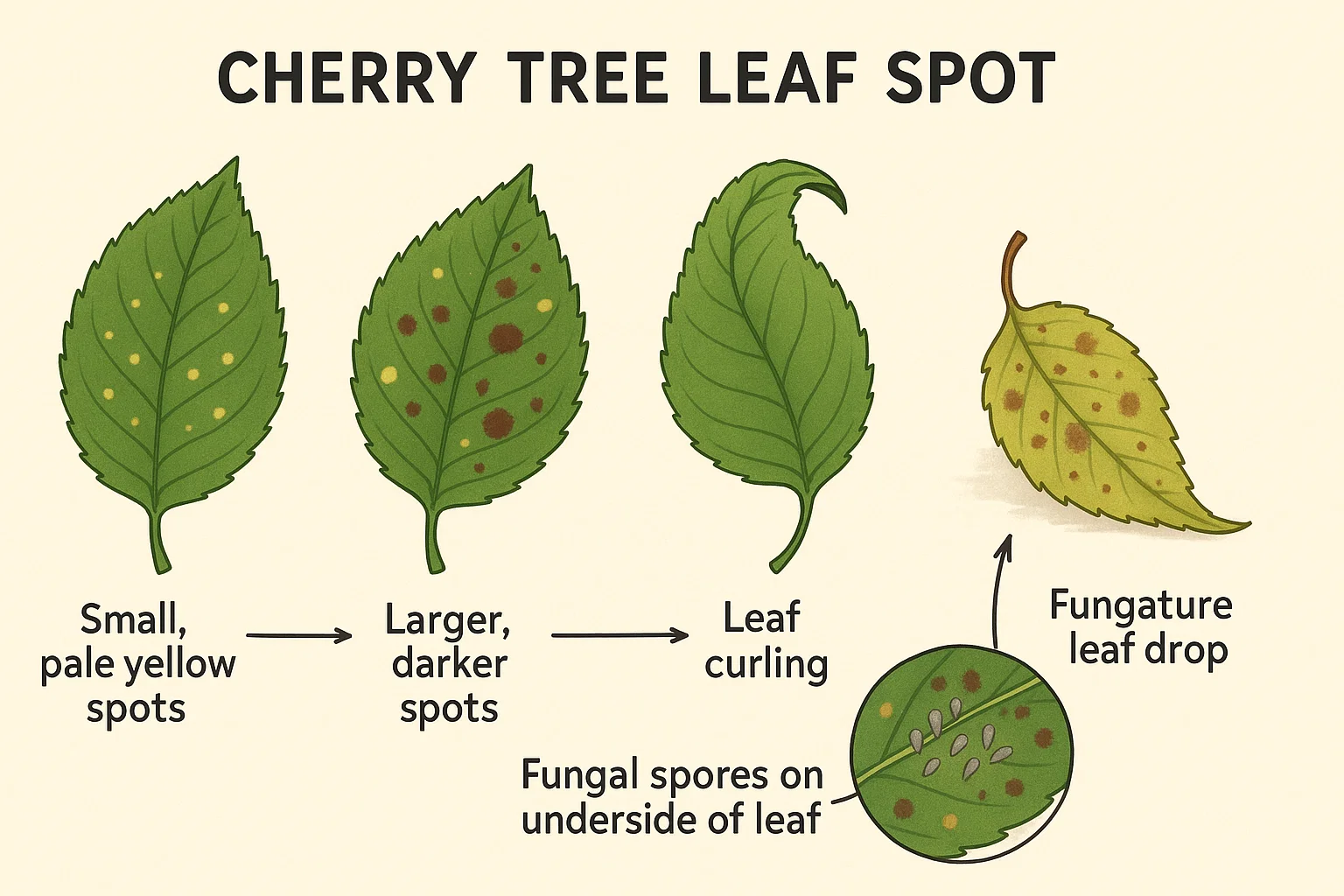
🍂 Leaf Spots 🍂
The first and most noticeable symptom of Cherry Tree Leaf Spot is the appearance of small, circular spots on the leaves. These spots typically start as pale yellow or greenish and darken to brown, black, or purple over time. They often have a yellowish halo around them. 🌿
🌳 Leaf Deformities 🌳
As the infection progresses, you may notice that the affected leaves begin to curl, shrivel, or distort. This can lead to an unsightly appearance and might affect the overall health of your tree. 🌳
🍂 Premature Leaf Drop 🍂
One of the most telling signs of leaf spot is when the infected leaves turn yellow or brown and fall off prematurely. This can occur throughout the growing season, especially in the warmer months. 🍂 Premature leaf drop weakens the tree’s ability to photosynthesize, making it more vulnerable to other stressors.
🍄 Fungal Spores 🍄
If you look closely, you might see small, dark spore masses on the underside of the affected leaves. These spores can spread to healthy leaves, causing new infections. This is most noticeable when the weather is wet or humid. 🌧️
🌧️ Timing of Appearance 🌧️
Cherry Tree Leaf Spot typically shows up in the spring and early summer, following periods of rainfall or high humidity. The disease thrives in moist conditions, so you’re more likely to notice it when the weather is wet. 🌧️
🍒 Leaf Spot Progression 🍒
As the disease spreads, the spots grow larger and merge, eventually causing the leaves to weaken and drop off. This can lead to a significant loss of foliage, leaving the tree stressed and less able to produce fruit. 🍒
By keeping a close eye on your cherry tree and regularly inspecting the leaves, you can catch the disease early and take action before it has a chance to cause too much damage. Identifying the disease early is the first step in managing Cherry Tree Leaf Spot effectively. 🌱
🌧️🌿 Causes and Risk Factors for Cherry Tree Leaf Spot 🌿🌧️
Understanding the causes and risk factors of Cherry Tree Leaf Spot is crucial for preventing and managing the disease. Here’s what you need to know:
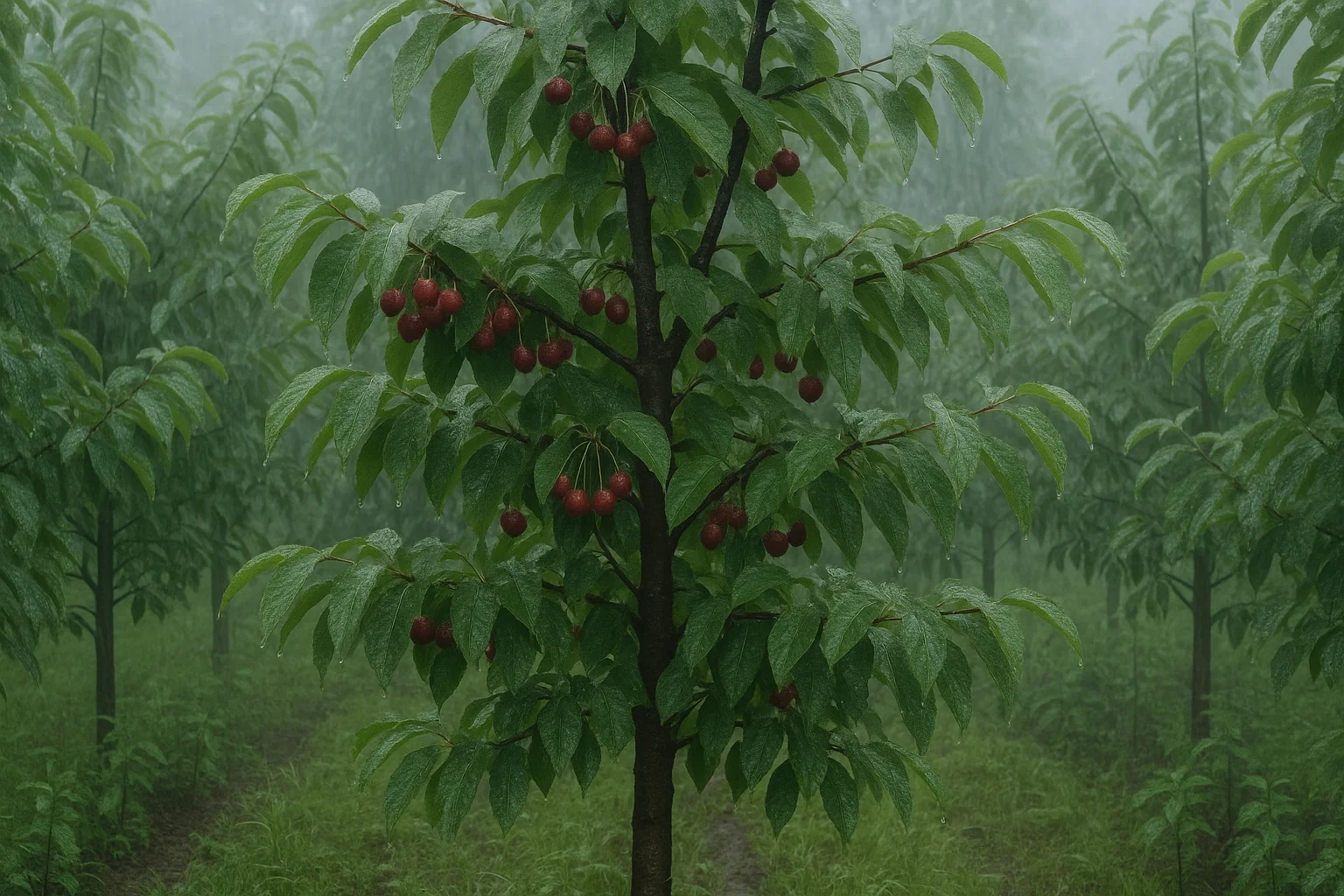
💧 Moisture and Humidity 💧
The primary cause of Cherry Tree Leaf Spot is fungal spores, which thrive in wet, humid conditions. Heavy rainfall, morning dew, and high humidity create the perfect environment for the fungi to spread. 🌧️ If your cherry tree is in an area with frequent rain or if it’s overwatered, it’s more susceptible to infection.
🍃 Poor Air Circulation 🍃
Cherry trees planted too close together or those with thick canopies can suffer from poor air circulation. This trapped moisture around the leaves encourages fungal growth. Proper spacing between trees and regular pruning can improve airflow and reduce the risk of leaf spot. ✂️
🌳 Weak or Stressed Trees 🌳
Trees that are stressed due to poor soil, lack of nutrients, or improper watering are more vulnerable to disease. A weakened immune system makes it easier for fungi to take hold. Keep your cherry tree healthy with regular feeding, proper watering practices, and maintaining soil health to reduce stress. 🌱
🔧 Lack of Maintenance 🔧
Not removing fallen leaves or infected plant material from around the tree can increase the risk of leaf spot. The spores from fallen leaves can survive through the winter and reinfect the tree the next season. Always clean up debris from around the base of the tree to reduce fungal spore buildup. 🍂
🌳🌳 Overcrowding 🌳🌳
If cherry trees are planted too close to each other, the lack of space can create a humid microclimate under the canopy. This is a perfect breeding ground for fungal infections. Ensure that your trees have adequate spacing to allow for proper sunlight and air circulation.
🌦️ Weather Conditions 🌦️
Spring and early summer are prime seasons for Cherry Tree Leaf Spot. Warm temperatures combined with frequent rain create the ideal environment for fungal spores to infect your tree. Pay extra attention to your tree during these wetter months, as it’s when leaf spot is most likely to appear.
By addressing these risk factors and keeping your cherry tree in good health, you can significantly reduce the chances of encountering Cherry Tree Leaf Spot. Regular maintenance and environmental awareness are key to keeping your tree strong and disease-free. 🌳🍒
🛡️🌿 How to Prevent Cherry Tree Leaf Spot 🌿🛡️
Preventing Cherry Tree Leaf Spot is all about creating the right growing conditions and practicing good tree care. Here are some effective ways to keep your cherry tree healthy and reduce the risk of leaf spot:
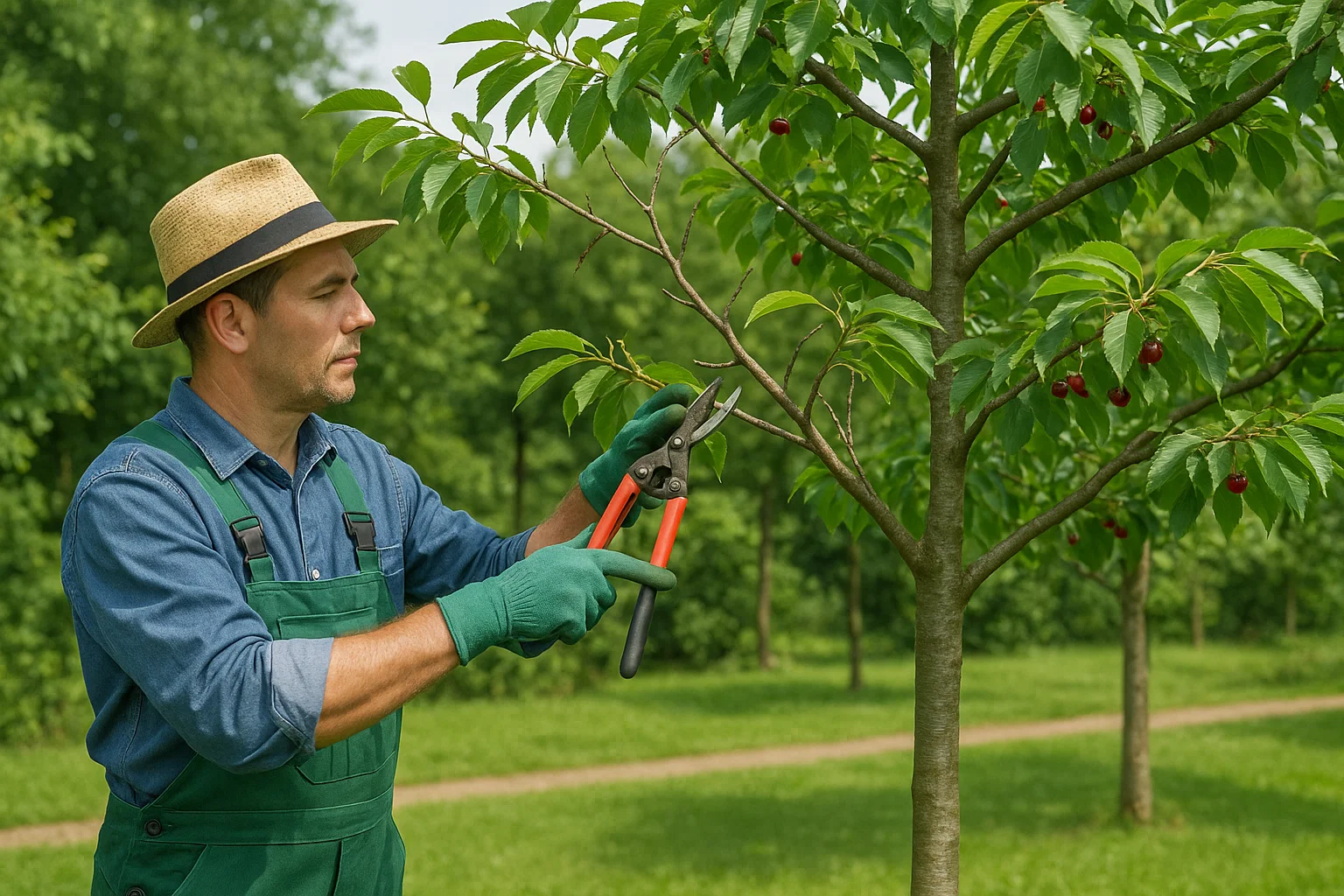
✂️ Proper Spacing and Pruning ✂️
- Ensure your cherry tree has enough space to grow. Proper spacing between trees allows for better air circulation, which helps prevent moisture buildup that fosters fungal growth.
- Regularly prune your tree to remove dead or diseased branches, and thin out the canopy to improve airflow. Better airflow means less humidity around the leaves, reducing the likelihood of infection.
💧 Watering Techniques 💧
- Water your cherry tree at the base, not over the leaves, to avoid wetting the foliage. Wet leaves are more susceptible to fungal spores. Try watering early in the day so the soil can dry by evening, reducing moisture on the leaves overnight.
- Avoid overwatering, as soggy soil can weaken the tree and make it more vulnerable to disease. Make sure the soil is well-draining.
🧴 Use Fungicides for Prevention 🧴
- Apply a preventive fungicide during the early spring, before new growth begins. Fungicides can help protect your tree from fungal infections, especially during wet periods. Be sure to follow the instructions carefully for best results.
- If you prefer organic solutions, neem oil or copper-based fungicides are effective alternatives.
🍂 Remove Infected Leaves and Debris 🍂
- Clean up fallen leaves and infected plant material around the base of your tree regularly. This reduces the buildup of fungal spores and prevents reinfection the following season. Dispose of infected leaves properly—don’t compost them, as the spores can survive and spread.
🌱 Maintain Tree Health 🌱
- Healthy trees are less likely to succumb to diseases. Feed your cherry tree with balanced fertilizers to ensure it has the nutrients it needs to thrive. Proper nutrition strengthens the tree’s natural defenses against infections.
- Avoid stress by making sure your tree gets enough sunlight and isn’t overcrowded with other plants or trees.
🌳 Choose Resistant Varieties 🌳
- If you’re planting a new cherry tree, consider selecting a variety that’s more resistant to leaf spot. Some cherry tree varieties are naturally more tolerant to fungal infections, which can save you a lot of trouble in the long run.
By implementing these preventive measures, you can help your cherry tree stay strong, healthy, and less vulnerable to the damaging effects of leaf spot. Prevention is always better than cure! For a detailed breakdown of symptoms and solutions, explore Cherry Tree Leaf Spot: How to Identify and Treat It.🌿💪
🛠️🍒 How to Treat Cherry Tree Leaf Spot 🍒🛠️
If your cherry tree is already showing signs of Leaf Spot, don’t worry! While it can’t be cured overnight, there are several steps you can take to manage and treat the disease. Here’s how to effectively treat Cherry Tree Leaf Spot and help your tree recover:
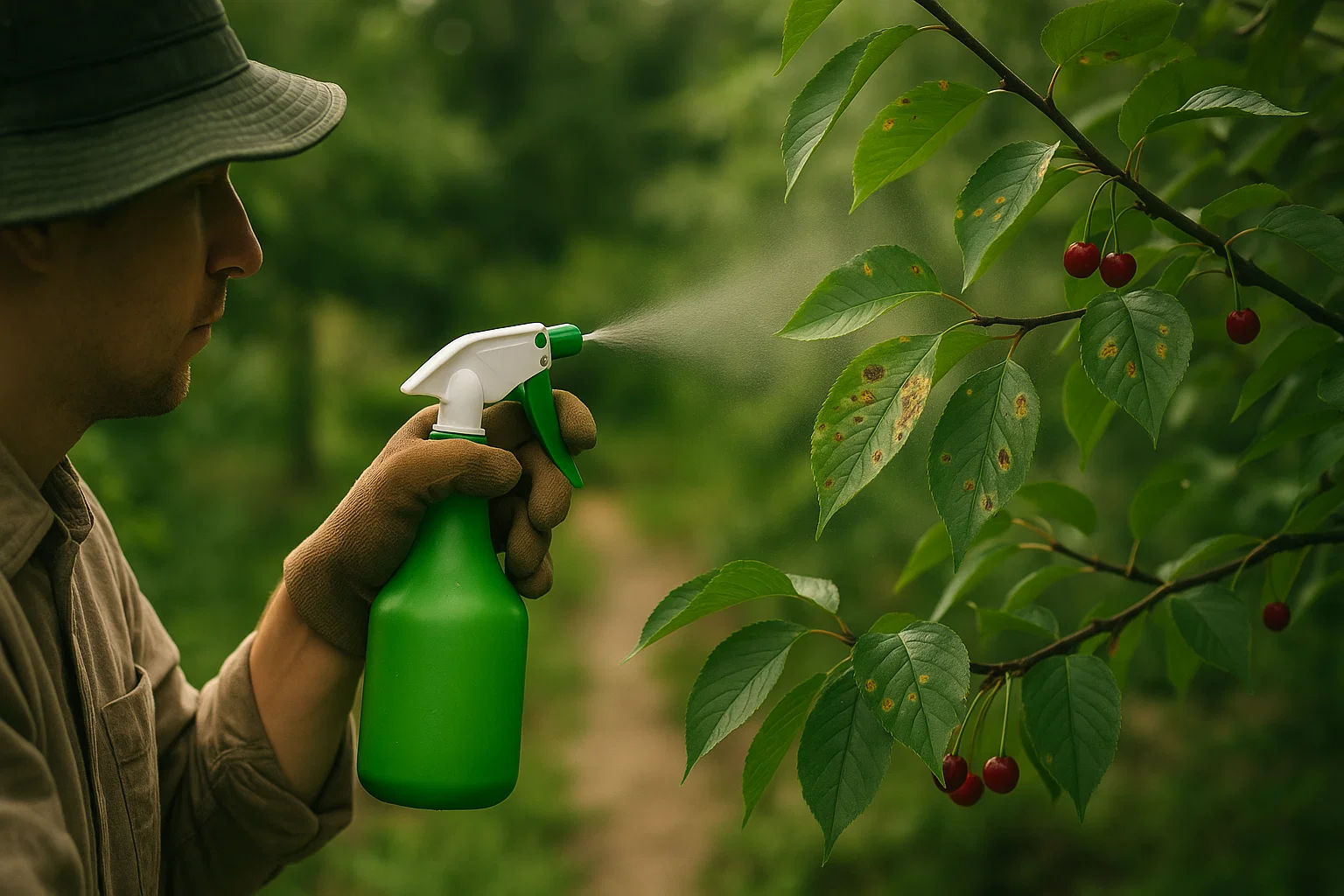
🍂 Remove Infected Leaves 🍂
- The first step in treatment is to remove any infected leaves from the tree and the ground around it. This helps to reduce the spread of fungal spores and prevents the disease from worsening. Be sure to dispose of the leaves in the trash—not the compost, as the spores can survive and spread to other plants.
🌱 Improve Tree Care 🌱
- Make sure your cherry tree is well-watered but not overwatered. Healthy, well-maintained trees are more resilient to diseases. Water the tree at the base, avoid wetting the foliage, and water early in the day to allow the tree to dry off before nightfall.
- Apply a balanced fertilizer to strengthen the tree’s immune system and help it recover from the stress caused by the disease.
🧴 Fungicide Application 🧴
- Fungicides are effective in treating Cherry Tree Leaf Spot, especially when used at the right time. If your tree is infected, apply a fungicide to the affected areas. Copper-based fungicides or neem oil are organic options that are gentle yet effective.
- For best results, apply the fungicide in early spring, before new growth appears, and again during the growing season if necessary. Always follow the product instructions carefully for the most effective treatment.
✂️ Prune for Air Circulation ✂️
- Prune any thick or overcrowded branches to improve air circulation around the tree. Good airflow helps reduce moisture buildup, which is ideal for preventing further fungal growth. Pruning also helps the tree focus its energy on healthy growth rather than fighting off infections.
🌿 Mulch Around the Base 🌿
- Adding mulch around the base of your cherry tree can help protect its roots and reduce soil moisture fluctuations. However, make sure the mulch is not piled against the trunk, as this can create a damp environment for fungi to thrive.
👀 Monitor and Maintain 👀
- Regularly inspect your tree for signs of recurring leaf spot or other issues. Early detection can help you act quickly and prevent the disease from spreading further.
- Continue to care for your tree by maintaining proper watering, fertilizing, and pruning practices to support its long-term health.
By taking these steps, you can effectively manage Cherry Tree Leaf Spot and give your tree the best chance to thrive. Timely treatment and consistent care will help your cherry tree recover, ensuring it remains healthy and productive. For a complete guide on symptoms, causes, and cures, refer to Cherry Tree Leaf Spot: How to Identify and Treat It.🌳🍒
Long-Term Care for Healthy Cherry Trees 💚🌳
Maintaining long-term health for your cherry tree is essential to prevent future diseases like Leaf Spot and ensure it thrives for years to come. Here are some key tips to keep your cherry tree strong, healthy, and productive:
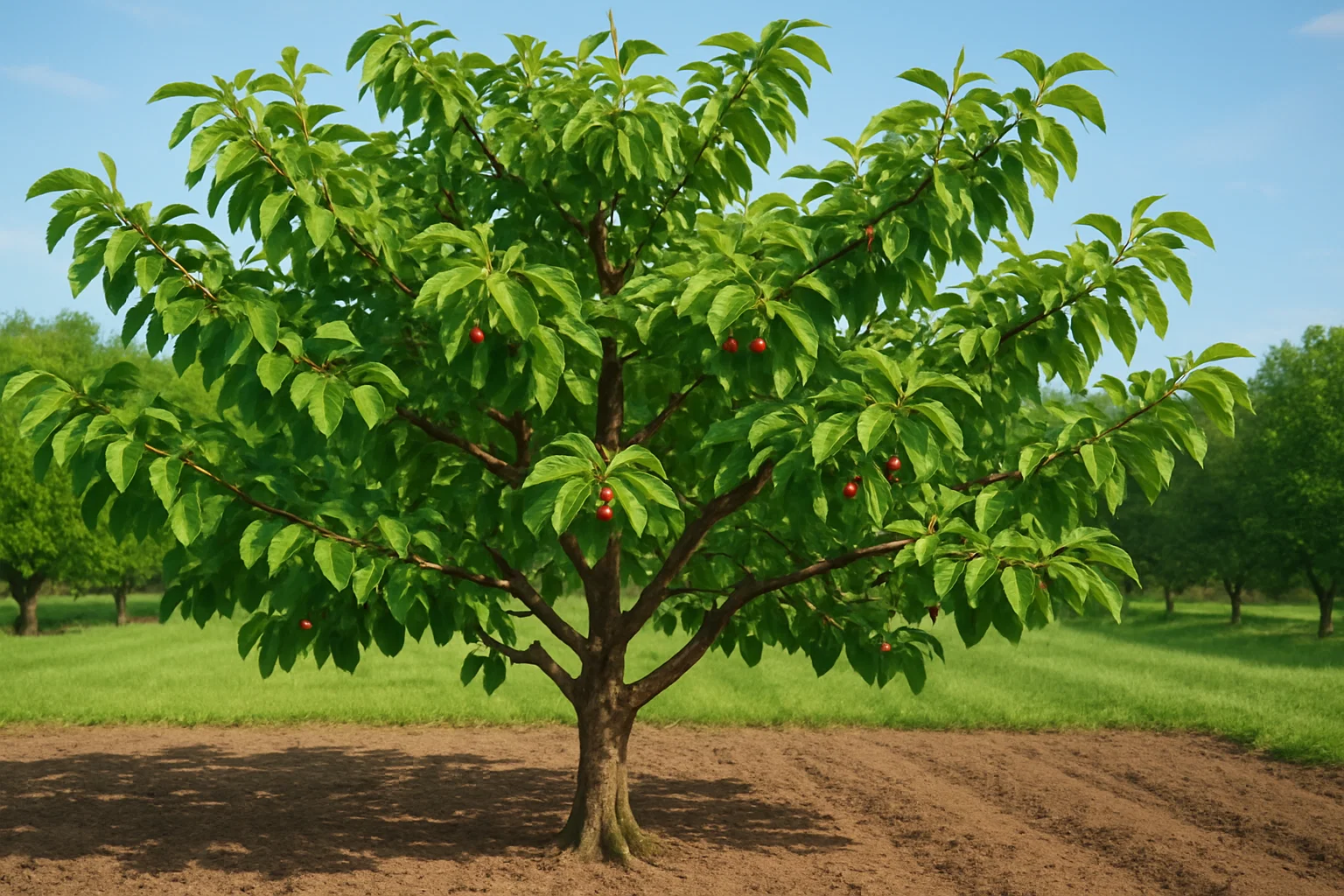
🔍 Regular Inspections 🔍
- Check your cherry tree regularly for signs of diseases or pests, especially during the growing season. Early detection allows you to address issues before they become serious problems.
- Look for unusual spots on leaves, wilting, or changes in fruit production—signs that something might be wrong.
✂️ Prune and Shape Your Tree ✂️
- Pruning is not just about removing dead or diseased branches. Properly prune your cherry tree to maintain a strong structure, improve airflow, and allow sunlight to reach all areas of the tree. This reduces the risk of fungal infections like Leaf Spot by limiting the humidity around the leaves.
- Prune during the dormant season (late winter or early spring) to avoid cutting branches with active growth.
💧🌱 Maintain Proper Watering and Nutrition 💧🌱
- Healthy trees are better at resisting diseases. Water your cherry tree deeply and consistently, but avoid overwatering. Ensure that the soil drains well to prevent root rot.
- Fertilize your tree annually, ideally in the spring, to provide it with the necessary nutrients for strong growth. Use a balanced fertilizer that supports overall tree health and helps it produce lush foliage and fruit.
🌾 Mulch to Protect the Soil 🌾
- Apply a layer of organic mulch around the base of your cherry tree to retain moisture, suppress weeds, and regulate soil temperature. However, be careful not to pile mulch too high around the trunk, as this can cause moisture buildup and invite disease.
- Keep the mulch a few inches away from the trunk to prevent fungal growth.
🌳 Choose Resistant Varieties 🌳
- When planting new cherry trees, opt for varieties that are naturally resistant to common diseases like Leaf Spot. These varieties tend to be more resilient and will require less care and attention over time.
- Talk to your local nursery or gardening expert for recommendations on disease-resistant cherry tree varieties suited to your area.
🍒 Proper Harvesting and Cleanup 🍒
- After your tree produces fruit, make sure to harvest it promptly to avoid attracting pests and fungal diseases.
- Remove any fallen fruit, leaves, or branches from around the tree to reduce the chance of reinfection with fungal spores over the winter.
🌦️ Watch for Environmental Stress 🌦️
- Keep an eye on environmental conditions such as excessive heat, drought, or frost. Stress from environmental factors can make your cherry tree more vulnerable to diseases.
- Consider installing a drip irrigation system to provide consistent watering during dry spells and protect the tree’s roots.
By following these long-term care practices, your cherry tree will remain healthy, strong, and more resistant to diseases like Leaf Spot. A well-cared-for tree is not only more beautiful but also more productive, ensuring you’ll enjoy sweet cherries and vibrant foliage for years to come! 🍒🌳
🌟 Final Thoughts 🌟
Taking care of your cherry tree is a rewarding experience that requires attention, patience, and consistency. By following the right preventive measures, treatment methods, and long-term care practices, you can ensure that your tree remains healthy, strong, and productive for years to come. For help managing common issues like leaf diseases, check out Cherry Tree Leaf Spot: How to Identify and Treat It for expert tips and solutions.🌳💚
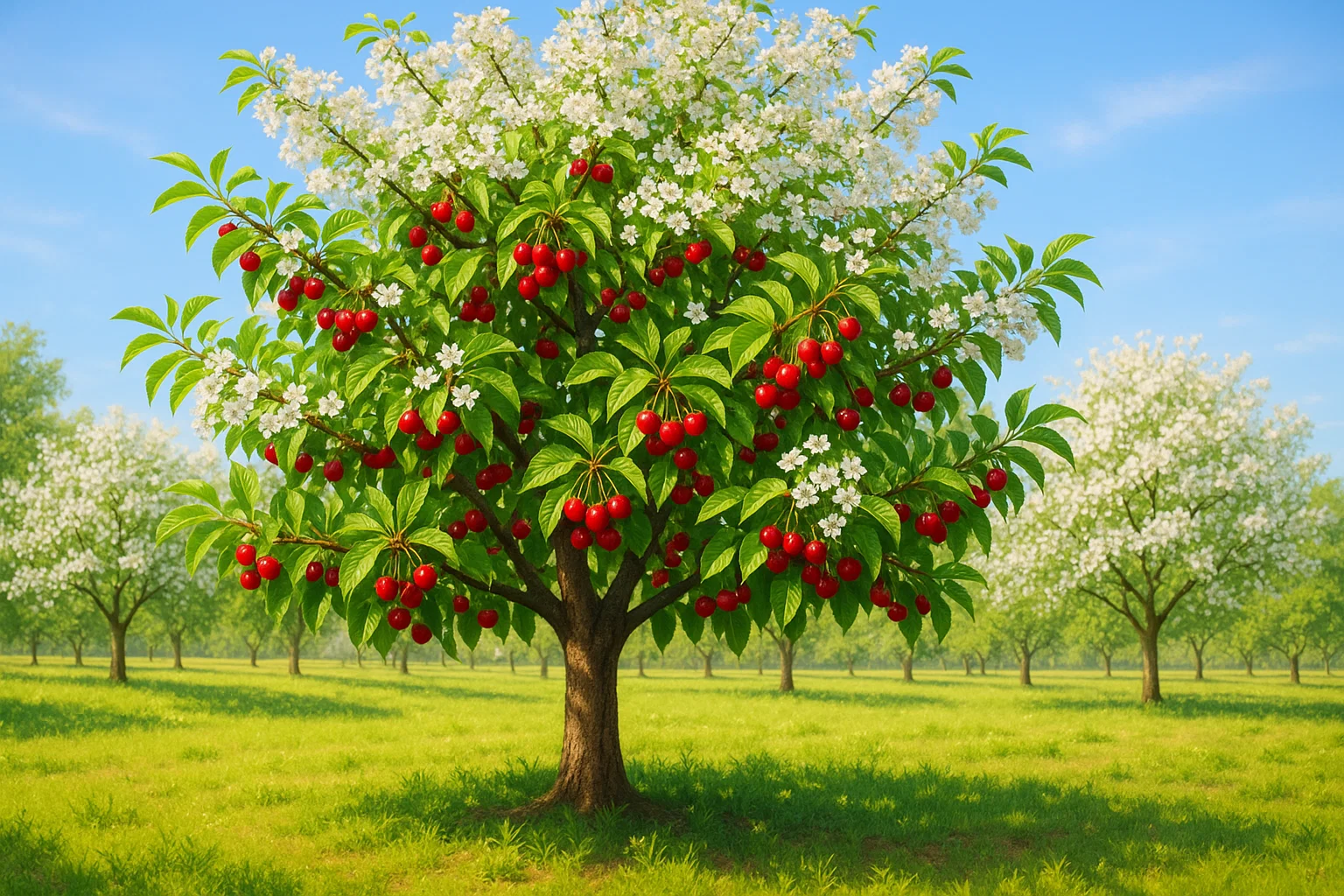
Remember, early detection is key when it comes to diseases like Cherry Tree Leaf Spot. Keep an eye on your tree’s health, take action when needed, and provide the right growing conditions for it to thrive. With proper care, you’ll enjoy beautiful foliage, abundant fruit, and a tree that stands strong against future challenges. 🍒
Frequently Asked Questions (FAQ)
What causes Cherry Tree Leaf Spot?
Cherry Tree Leaf Spot is caused by fungal spores that thrive in wet, humid conditions. Poor air circulation and overwatering can also increase the risk.
How can I identify Cherry Tree Leaf Spot?
Look for small, dark spots with a yellow halo on the leaves. Affected leaves may also curl or drop prematurely.
Can Cherry Tree Leaf Spot spread to other trees?
Yes, the fungal spores can spread to other cherry trees and plants, especially in damp, crowded conditions.
When is the best time to treat Cherry Tree Leaf Spot?
The best time to treat Cherry Tree Leaf Spot is in early spring, before new growth begins, and again during the growing season as needed.
Is fungicide effective for Cherry Tree Leaf Spot?
Yes, fungicides can help prevent and treat Cherry Tree Leaf Spot. Copper-based or organic fungicides like neem oil are effective options.
How often should I prune my cherry tree to prevent leaf spot?
Prune your cherry tree in late winter or early spring to improve air circulation and remove any dead or diseased branches.
Can Cherry Tree Leaf Spot be cured?
While the disease can’t be completely cured, timely treatment with fungicides and proper care can minimize damage and prevent its spread.
What is the best way to prevent Cherry Tree Leaf Spot?
Preventive measures include proper spacing, watering at the base, using fungicides, and regularly removing infected leaves and debris.
